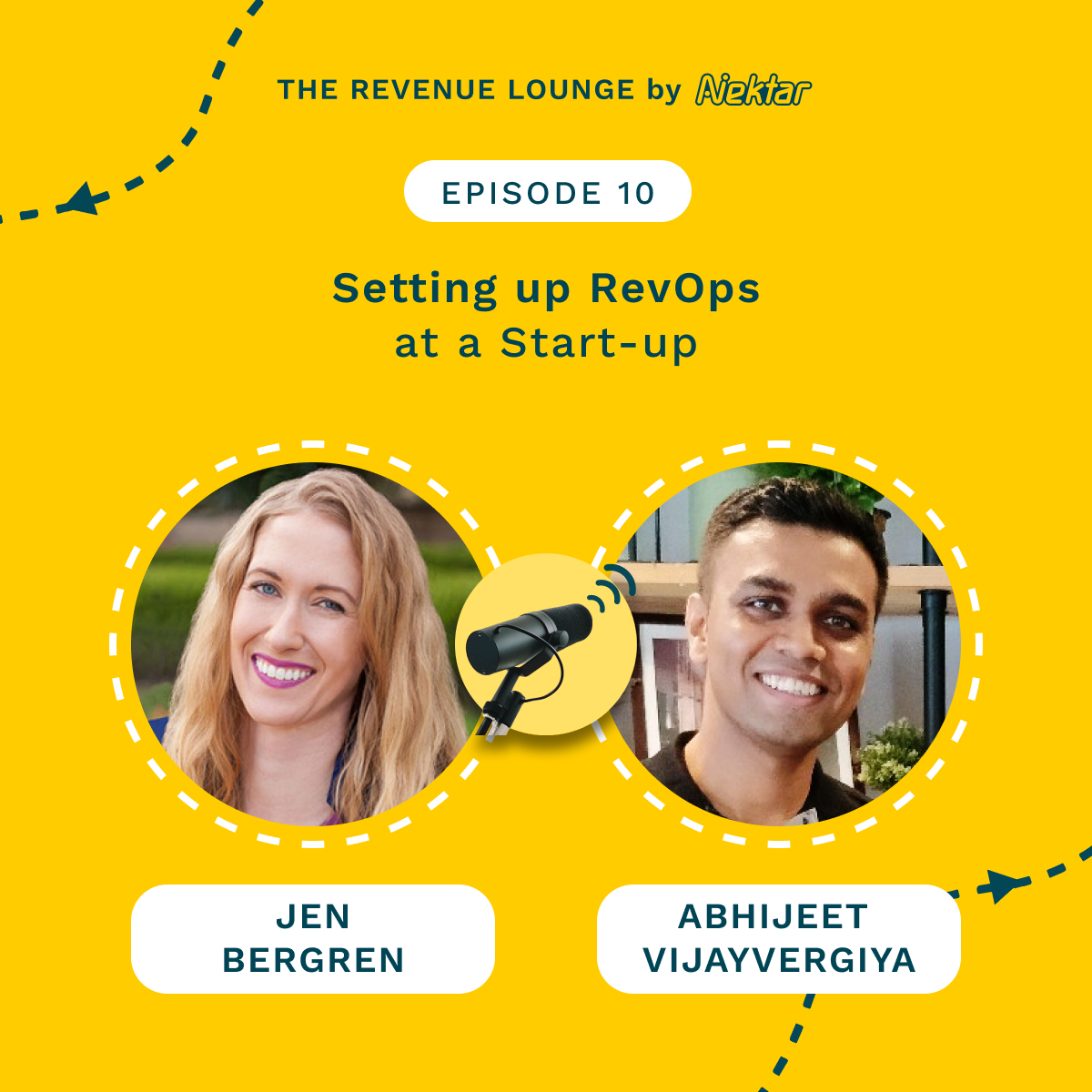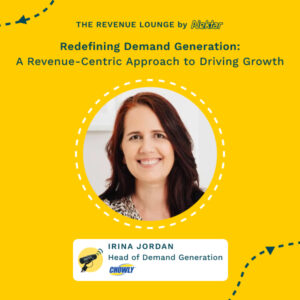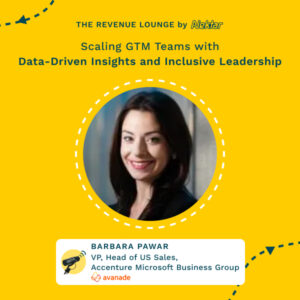Strategic Revenue Operations: Harnessing Data for Maximum Impact ft. Kelley Jarrett
August 21, 2024
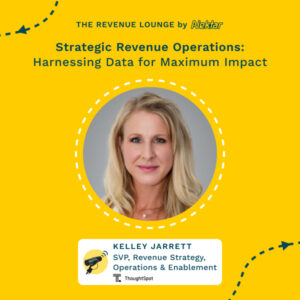
About
The Revenue Lounge
The podcast covers stories from leaders across RevOps, Sales, Customer Success, GTM, Data and Marketing about what drives these functions and what advice they would share with our listeners. With 3 seasons recorded, the podcast currently features 50+ enterprise leaders in the B2B SaaS domain. Tune in to hear from the best in the business
In this episode of the Revenue Lounge podcast, host Randy Likas interviews Kelley Jarrett, SVP, Revenue Strategy, Operations and Enablement at ThoughtSpot, about strategic revenue operations. They discuss how to leverage data to unlock growth opportunities and maximize business impact.
# Discussion Points
– Kelley’s career path across various go-to-market roles over 20 years
– How revenue operations has evolved to be more strategic and aligned with business priorities
– Common data challenges faced by revenue ops teams and ways to overcome them
– Leveraging data to identify pipeline growth opportunities across marketing, sales, partnerships
– Change management required to implement cross-functional programs
– Adapting to changing buyer dynamics with buying groups and buying signals
– Structuring a revenue operations team with specialized verticals and business alignment
# Guest Bio
Kelley Jarrett is SVP of Revenue Excellence at ThoughtSpot, a business intelligence and analytics platform. She has over 20 years of experience across sales, marketing, product marketing, revenue operations, and enablement roles at companies like Blackbaud and Gainsight.
# Company Bio
ThoughtSpot provides a search and AI-driven analytics platform to help businesses analyze their data and make insights-driven decisions.
# Quotes
“I hired recently a director of CS operations, never learned more from her…than I have with almost anyone I’ve worked with because that was new for me.” (00:33:40)
“If operations sits with the go to market team, it really creates that balance.” (00:08:11)
“The hardest part is probably the remote work…making sure that you stay engaged and build a culture, it’s really hard to do in a remote environment.” (00:34:05)
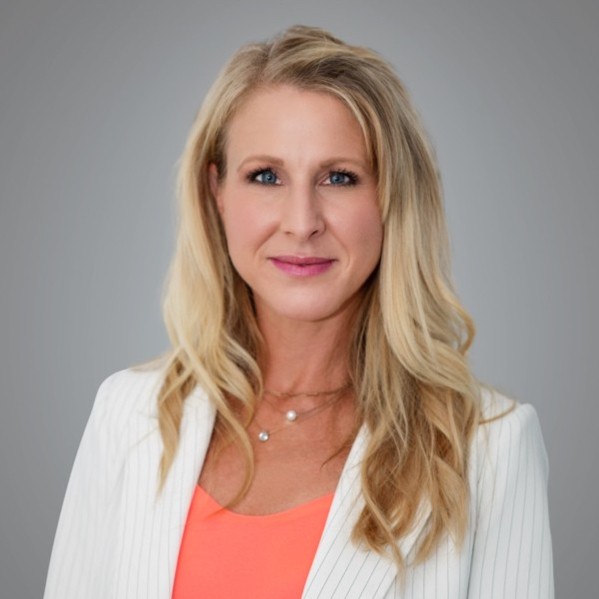
Randy Likas (00:01.123)
Hello everyone, welcome to another episode of the Revenue Lounge. I am your host, Randy Likas. And today’s theme, we’re gonna focus on strategic revenue operations and how to harness data to unlock growth and maximize business impact. Joining me today is Kelly Jarrett. Kelly is the Senior Vice President of Revenue Excellence at ThoughtSpot. She has over 20 years experience serving in many different go -to -market roles from sales, marketing, product marketing, revenue operations, and enablement.
Kelley, I am very much excited to speak with you today. Welcome to the Revenue Lounge.
Kelley Jarrett (00:33.196)
Yeah, thanks, Randy. I’m really excited to be here to chat with you.
Randy Likas (00:36.579)
Great. So I would love to just kind of start and talk a little bit about your background. You know, what kind of got you into revenue operations? Everybody’s kind of got their own story, right? Revenue operations is typically not something people start with when they go to school. They think about that. So we’d love to hear sort of some of the roles that had prior to, you know, getting into go -to -market operations and a little bit more about the sort of your role today at Thought
Kelley Jarrett (00:58.22)
Yeah, sure. I’ll kind of start at the beginning and go really fast because my background is a little bit all over the place. I actually had a mentor early in my tech career that told me, you know, that I should really kind of think about whether I want to take a generalist track or a specialist track because they’re pretty different, right? You can go up the ranks in marketing or sales or operations and kind of learn the…
specifics of that role and move up the ranks that way or a generalist of course is kind of learning all the different pieces and parts of a tech company or any industry and the different elements and functions and how they work together. It’s kind of a no -brainer for me. I am very interested in learning how all things work together. So that’s the track that I set out on and I’ve been following that generalist track ever since. I started my tech career in sales, direct sales and
did a lot of sales and sales support in the beginning of my career, which kind of was a great springboard to really anything I wanted to do next. Once you have the understanding of the products you’re positioning and selling and talk to the market and to customers, it opens up a lot of opportunity. So from there, I wanted to learn a little bit more about the post sales organization. So as part of the Solutions Consulting team at that time,
moved into the professional services organization and then took on some leadership roles in customer success and professional services. I did that, really enjoyed learning the post sales world, but I think I knew at that point my passion was really more on the go -to -market side. So when an opportunity opened up to move back onto the go -to -market team and start leading the product marketing function, this was at a company called BlackBod.
I took the chance and learned a lot. That’s where my kind of passion for revenue operations really started. Product marketing, I think any good product marketing function, you have to be extremely data driven. You have to understand how to slice and dice the market, market research, everything from, know, TAM, SAM, SOM to understanding how you’re performing with certain products so that you can more effectively position them in market. So that was my first
Kelley Jarrett (03:14.158)
introduction to operations. And then, know, kind of long story short, that’s where I started focusing my time. Every role I took thereafter was really oriented around learning more about how revenue operations could support all aspects of a tech company and SaaS business in particular. So I led revenue operations and enablement at Gainsight and then was recruited by actually my CRO at Gainsight
Randy Likas (03:16.675)
Huh?
Randy Likas (03:34.551)
Mm
Kelley Jarrett (03:43.488)
lead strategy operations and enablement at ThoughtSpot. That’s where I am today. And really just an opportunity to leverage data to make better business decisions has kind of driven the way that I think about my role and the way that I think about any role that I’ll have in the future and my contribution to the business.
Randy Likas (04:02.679)
Yeah, that’s wonderful. Curious, like when you are hiring to build out your team, what do you look for? Do you look for generalists or do you look for specialists?
Kelley Jarrett (04:11.5)
A little bit of both. think if you are a generalist, a lot of times that means you don’t always have every piece of the role that you are directing, right? So you might not necessarily know how to build a capacity model, but you need that in revenue operations to be successful. So I definitely hire specialists for the skills that I need to round out my role or to hire for my weaknesses, so to speak. But I also think that, you know,
thinking outside the box a little bit on hiring is also important. Like I’ve hired folks that have not necessarily had a revenue operations background, but have strong connections into sales leadership, for example. On the enablement side, I’ve hired a teacher before who wanted to get into tech. So these are things I think it’s good to think about as you’re hiring, but I think to answer your question directly, you really need both to have a successful, well -rounded diverse team.
Randy Likas (04:53.741)
Right.
Randy Likas (05:08.909)
Yeah. You know, I want to get a little meta here and maybe full focus on like the last three and a half years of your career for the next question or two, which is really around how revenue operations has changed. Right. So I’ve been in like sales tech rev ops world for probably around that same time, three and a half years, but I’ve been a sales guy my entire career. But, you know, in the past three and half years, even when I was over at outreach, like so much has changed from then to now.
So maybe I’d love to hear your perspective. Like how has revenue operations evolved over the past couple of years, particularly I think like in terms of aligning to the strategic priorities of the business.
Kelley Jarrett (05:45.09)
Yeah, I mean, you you can see it in hiring now. You see a lot more strategy and revenue operations instead of just rev ops, right? Because I
The way that it was for a really long time is report building and getting data to be accessible in either dashboards or reports that we handed off to business leaders to then go and make decisions. I think it’s evolved to definitely be more of a partnership. So at least that’s been my experience, both in the roles that I’ve been in and revenue operations, as well as what I’m seeing in the market in terms of hiring. The level, right, they’re looking for senior.
leaders in revenue operations that really sit side by side with the likes of CROs and in some cases finance depending on the organization. And I think it’s, you know, it’s definitely growing in importance because the market is really valuing, evaluating metrics differently now. I think it used to be growth at all costs, right? And now it’s not. I think we’re seeing that, that a function of business health is healthy operations. And
know, most companies are really up leveling their operational leadership so that that individual or that team can really guide the strategy on the operation side just as much as it needs to drive marketing and sales and even CS. So I think we’ve become more of a key partnership to our business partners than ever before. And, you know, I think at ThoughtSpot
done this a lot recently in just a couple of examples. as we’re planning our next fiscal year, which just started yesterday, as we’re planning our next fiscal year, we’re not only taking the top level goals and translating those into reports and territories and capacity and quotas, we’re actually sitting in the room with the sea level resources and guiding.
Randy Likas (07:26.146)
Yeah.
Kelley Jarrett (07:46.744)
what they should be considering as they think about setting goals and talking to the board about financial obligations. So I think we’re just more of a partner these days.
Randy Likas (07:54.241)
Yeah, it’s interesting when I speak with different leaders like yourself who have strategic responsibilities for operations, where they actually report to in the organization, right? Sometimes it’s to a CRO, sometimes it’s a CFO, sometimes it’s a peer to those folks. Two questions, I guess. Where do you sort of fit in the organizational design of ThoughtSpot? And as you’ve talked to other peers, where do you typically see someone in your role fitting in kind of their org
Kelley Jarrett (08:22.518)
Yeah, I report to the CRO and I strongly feel like that’s the best way to do it and I’ll tell you why. There’s a healthy conflict that needs to occur between finance, CFO and the finance organization and the go -to -market team. And I think if operations sits with the go -to -market team, it really creates that balance. So we can sit in a room.
with finance and they’ll have their perspective from a financial perspective and we will give feedback on that based on what we know about, you know, things like team engagement and culture and, you know, what’s happened in the past and how we should make change slowly or more methodically rather than just looking at the bottom line, which of course we need finance to be doing as well. So I strongly feel like that’s the best, at least in my experience, the best structure because it gives that sort of check and
Randy Likas (09:07.341)
Mm -hmm.
Kelley Jarrett (09:15.016)
between the two organizations to have different perspectives but align on something that’s going to make sense for all teams involved as well as the financial commitments to the
Randy Likas (09:25.515)
Yeah. Yeah. I would agree with that. think that’s typically what we see as well. And for all the reasons you just stated, I think it makes the most sense. So ThoughtSpot’s a data company, right? It’s in your DNA. And so that probably helps here. But when it comes to like specifically go to market data at ThoughtSpot and maybe more generally, I guess, you know, what are some of the common challenges that you see, you know, rev ops teams having when trying to sort of harness data or unlock data to really support some of those strategic objectives that you’re trying to support?
Kelley Jarrett (09:56.28)
Yeah, I mean, think bottom line, it really comes down to accessibility of easy to read and understand data. I believe that. you know, one role ago, right, we had the difficulty of trying to support, as a rev ops team, business leaders and making decisions. So we would often build dashboards with several filters, as many as we could possibly think of that the business leaders would be requesting. And we would provide those to the business leaders,
which took some level of education and enablement first and foremost, they would finally find the time to sit down with those dashboards and they would review them and then they’d have a question that maybe was a nuance to a filter that we hadn’t yet thought of, right? So they would come back to RevOps and RevOps would have to go back and rebuild.
Randy Likas (10:41.871)
Mm -hmm.
Kelley Jarrett (10:47.31)
that dashboard to support that. we call that at ThoughtSpot, we call that the data backlog. And I never knew the word for it before, but I felt it when I was in RevOps at other companies. But the data backlog is a real challenge because RevOps really should be providing guidance and business, know, helping with business decisions rather than, you know, changing filters and kind of going back to the drawing board with data.
Randy Likas (11:10.677)
Right. Yeah.
Kelley Jarrett (11:13.23)
I think that’s a big challenge. think we’re seeing the industry shift a little bit, especially with GEN .AI and some of the tools. I ThoughtSpot obviously is one, there are several out there with the idea that we want to put data in the hands of business leaders. That’s what needs to happen. And I think that’s the biggest challenge is we’re still in that transition where RevOps is too, we’re too reliant on RevOps to be doing the building rather than helping business leaders.
see what they need to see in real time.
Randy Likas (11:43.585)
Yeah. What are your thoughts on the different tools that are out there that may be part of your stack today that are harvesting some amount of information, but maybe they’re not writing it back to Salesforce as the source of truth, right? They’re kind of keeping it within their own user interface and doing the analytics. But not everybody, not all functions have access to those tools. And so there’s kind of two schools of camp here. One is like, we want to try to get everything in Salesforce as a system of record because that’s where
like marketing automation could pick it up. But we’ve also seen a trend lately where it’s like, as long as all those other tools in our stack are able to export the data out to a data warehouse, like a snowflake or something else, like that might be okay. So just, I would love to understand sort of what your thoughts are there is, I guess the question is philosophically, like do we want to have Salesforce as our source of truth or?
Are we just looking at making ways to get the data in a data warehouse so that we can look at it sort of different data sets together and come up with our own insights?
Kelley Jarrett (12:49.122)
Yeah, I mean.
To me, this is kind of a no brainer. mean, we use Salesforce at ThoughtSpot and, you know, ideally sure everything would be there ready to use. But in reality, most companies don’t have it set up that way, nor does it necessarily make sense for it to be set up that way. So a couple of examples, Salesforce was built and made for a sales organization. We use it, we love it. We will never, well, I can’t say we’ll never get rid of it, but we just love Salesforce. We use it every day. However,
We have a strong and growing CS organization that has different needs, that needs to serve their customers with unique functionality and tools that are unique to their day to day and what will drive.
value and outcomes for the customers that Salesforce just doesn’t have in the tool itself. Same thing with marketing, same thing with other functions. So we’re always going to see that best in breed structure, I think, for functions to be able to do their jobs effectively. And so I strongly believe that a data warehouse is the way to go, right? Like you have this, we have this.
option that we didn’t have 10 years ago in the cloud data warehouses. You mentioned Snowflake, Databricks, there’s several out there, right? In Google Cloud, all of these are options
Kelley Jarrett (14:10.114)
we can now tap into that doesn’t require us as business leaders to force a function into a specific tool that may not be built for that. So I definitely think that’s the way to go. It gives you flexibility. gives you, yeah, just the ability to make the right functional decisions while not worrying too much about how you’re gonna get your data out, because that’s where it goes.
Randy Likas (14:31.203)
Yeah. Related to this, but I guess a slightly different angle is the idea on data cleanliness. So it’s amazing to me how many organizations I talk to who know that they have data cleansing issues, but they’ve learned to live with it. It’s just a fact of we’re never going to have it 100 % accurate.
But there’s also others who are like, it’s bad. We know it’s bad, but we’re still moving. We have to manage the business. So we’d love to get your perspective on how do you deal with the whole idea of data quality or data cleanliness?
Kelley Jarrett (15:03.678)
Yeah, I mean, this is a problem for every company, even data companies that know the importance of data cleanliness. just is. But I would say two things. One, every company should invest in a data strategy and it should be owned and someone should feel accountability for it when they wake up in the morning and go to bed at night. What is my data strategy from data integrity to cleanliness, to architecture, to output? All of those things should exist and live with a data team that has a clear
a strategy that is documented and leveraged. So I strongly believe that. I have a colleague, Cindy Howsen, who runs the Data Chief podcast, and she talks about this all the time. There are some great resources out there that folks could get access to basically just like how do you set up a data strategy? What does your data team look like? But however you do it, as long as there is someone that feels accountability for that and it clearly articulates it, that’s kind of one thing that I think would go a long way, maybe
80 % of the way to data cleanliness. Because the reality is it’s changing all the time. Your data is changing all the time. People move. Accounts consolidate. have all kinds of things happen where it’s not just a one and done thing. So someone continually looking out for that and making sure that they’re sharing actions with each of the functional leaders. It just needs to happen. We had a recent.
Randy Likas (16:04.407)
Mm
Kelley Jarrett (16:31.086)
recent experience with this, right? Like we were working on an invite list for a dinner, right? So just a very basic field event, marketing event. And when we were working with a tool, one of the tools that we use to get invites out, we were trying to pull a list together and it didn’t allow us to see where individuals lived working remotely for companies. was pulling.
the city and state of the actual company. And we all know that 85 % of the people that work there are probably remote these days, especially if it’s a tech company. So just little things like that. mean, people need to constantly be looking for real life examples in the business where we’re seeing data issues, feed that back to the data team to kind of solve those as the execution layer of a business problem, really. But it is a problem. It will continue to be a problem. I would just say, you
Randy Likas (17:22.669)
Yep.
Kelley Jarrett (17:27.074)
kind of to recap data team, data strategy, documentation and process.
Randy Likas (17:32.963)
Yep, 100%. So can you give me an example maybe of where your teams and maybe the people on your teams have been able to leverage the data to help the business leaders, whether it be marketing, sales, CS, understand growth opportunities? Maybe there were some gaps where they saw the data and they identified some ways in which we can grow the business.
I don’t want to leave the question, so I’ll just kind of leave it there. What are your thoughts?
Kelley Jarrett (18:04.498)
Yeah, so we recently I mean, you know like like you said in the beginning I work for a thought spot we have a tool that is you could leverage other tools for the same thing But I’ll share it in the context of thought spot because that’s the world I live in now, but we created a live board which allows for access to all things pipeline generation, right and I wanted to be able to
you know, not just marketing source pipeline generation, but every source pipeline generation so that we could start to understand which sources were most effective, what channels were working and what were not. Were, you know, were our sales team actually prospecting or were they not? And what did that look like compared to prior years? So we created a live board to kind of give us a little bit more insight into what was happening with our pipeline generation.
I know this is a common struggle because I’ve talked to a lot of leaders as well right now, just pipeline in general, like the SaaS industry is just getting tighter. So we did that. And the first thing we did was sat down as a team to review the slide board and what it was spitting out for us. And we understood that two things were happening. One, we were starting to see a level out of our pipeline production by source. We had strength in sales source pipeline.
Randy Likas (19:07.329)
Yeah.
Kelley Jarrett (19:26.178)
we had some weaknesses in marketing source pipeline. And we were able to use that top line data to then say, okay, why, why, why, why? ThoughtSpot has some tools built in to allow to ask those questions. And you started to uncover certain channels weren’t performing. We had limited ability to, marketability within our data. So kind of back to the data problem that you were talking about.
Randy Likas (19:54.947)
Hmm.
Kelley Jarrett (19:54.988)
So long story short, we found that we had some gaps in our ability to source pipeline from certain places that we should be sourcing pipeline from. So we translated that to the business leaders and talked through what are some of the things that we could go do to solve that problem. And we created a integrated pipeline team that took the data and put in place programs to support, you know, the four key sources, right? We’ve got marketing, we’ve got sales, we’ve got SDR, and we’ve got partner.
And we did a pilot integrated pipeline plan around one campaign that allowed us to test new strategies to see if we could move the needle. And we essentially did an AB. We looked at our current state live board. We implemented the program for one campaign. In our case, it was the Gartner Magic Quadrant campaign, because that was a really exciting, exciting news for us.
Randy Likas (20:47.667)
yeah. You’re up with that upper right hand quadrant now. That’s,
Kelley Jarrett (20:51.016)
We are a leader, yeah, super exciting. So we leveraged that campaign to test out this pipeline program and we were able to see exactly what that did in every source compared to the baseline that we had in our live board. So that was a real time use because we realized two things. One, there are a couple of channels that we weren’t leveraging enough that we put more time, resources and money into because they were working. And we also realized we were under leveraging our partners.
So we worked with the partner team to provide direct links, put together a better together story and allow them to share the Magic Quadrant news in the context of how we work with our partners. All of that drove more pipeline than we had seen before. So kind of a long example, hopefully that was fine. But yeah, mean, we continue to kind of evolve based on what we’re seeing in the
Randy Likas (21:37.901)
Great example. Yeah, that was great.
Randy Likas (21:43.879)
That’s a great story. And I think what’s really interesting, what I’d love to get to ask a follow on is, it’s probably a big change of how you were doing it before, right? So, you know, as best as marketing and sales teams try to work together, like they’ve got a lot of times independent metrics. And so I guess my question is like, there’s probably a lot of change management that had to go to sort of get that initial pilot running. Can you talk about that? Like, how do you approach that from a change management perspective to…
work with the different functions to kind of get them a aligned and like a cross functional campaign.
Kelley Jarrett (22:18.704)
Yeah, it’s a great question. First and foremost, we
there was an individual who was looking to learn a little bit more about marketing and sales. She was doing some work in chief of staff world and she’s amazing and we love her and we’re like, yes, will you come help us kind of own this as a program? So first of all, accountability for one person to kind of bring everything together, make sure we have the meeting set up and we had templates to use, that was key. The second thing was I mentioned to the live board that showed current state that we created. We took that and we
the functional leaders down, right, the heads of sales, the head of marketing, the head of SDR, and the head of partner, and we showed them what was happening and where there were gaps and where we still had open questions that we couldn’t answer. And we basically got them to agree that this is a problem. If they don’t agree it’s a problem, then we don’t need to solve it because they will not necessarily support that. We got them to agree it was a problem.
And then we got them to commit to running the program through their teams. It’s one thing for our operations and enablement team to understand what’s happening and help guide a program to support change. But I always tell my team, a rev ops leader or a sales enablement leader should never be running a program and announcing a program. They should hold the teams accountable.
They should give all the tools and education and enablement needed to support the program, but the functional leaders need to own it. So the head of sales needs to be able to stand in front of their team, set expectations, let them know that this is a priority so that the teams will support it. So we did those things. We shared, we agreed that there was a problem. We put a program in place. We enabled the leaders to be able to take that to their teams. We gave them things like inspection reports and stuff like that to support
Randy Likas (23:48.568)
Yeah.
Kelley Jarrett (24:18.766)
And then we supported it, right? We told them what was working, what was not, who was participating, who was not, and we let them run their business because that’s their job. So that’s kind of the way that we work and the way that I think a rev ops and enablement function should work is more of a supporting role. That’s why we call ourselves Revenue Excellence, right? We’re here to support those teams and those leaders to do their jobs effectively.
Randy Likas (24:29.409)
Yeah. Yeah.
Randy Likas (24:42.561)
Yeah, that’s a wonderful story. Can you talk a little bit about, I mean, maybe not specific numbers, but from that initial pilot project that was, sounds like deemed a success, like how big of an improvement was that from what you were seeing before, know, sort of pre and post?
Kelley Jarrett (24:56.726)
Yeah, I’d love to share a quote from Gartner. I need to make sure that I get it right, but I’ll give you the gist of it. But we got a note from Gartner that told our head of brand that it was the best performing demand campaign for the Magic Quadrant they had seen to date. So I don’t know how I’m gonna quote that individual or not, or maybe my brand person will slap me on the wrist for that. But we did get that note and that email.
So whether that was qualitative or quantitative, we’ll have to let you know. But it was really great to hear it from the Gartner team that they were seeing the success of that, which was pretty exciting for us. But that alone was a win. For us, the other part of the win was we had observed that the sales -driven
was pretty kind of stagnant, right? They weren’t prospecting as much as maybe we wanted them to and the leaders wanted them to. So part of the program was to give them the resources and tools to be able to do that more effectively, which was great. And they showed up as the fourth highest MQL, or in this case, it would be SAL or SQL, depending on how you look at your funnel. But they showed up as the fourth highest in terms of leads.
generated by the sales team themselves, which they wouldn’t have been on the board for a campaign like this. It would have been traditionally thought of as a marketing campaign, but they participated. They ran their own campaign as well, and we saw the results from that, which was really great.
Randy Likas (26:33.057)
Yeah, and so now is it being deployed company -wide now, or how is it going? What’s sort of the next phase of
Kelley Jarrett (26:39.554)
Yeah, great question. we in our marketing team, we have what we call pillar moments. They’re essentially big things that happen throughout the year that we want to rally around. Typically, those have lived in marketing as big campaigns, which they still will. But we’ve decided to orient around, you know, five or six pillar moments to align around the what we call the IPP, the Integrated Pipeline Plan. And the next one up, we’re doing a research paper that launches in September that we’re going to rally
for our next iteration of this. We’ve got some lessons learned, we’ve got some things that went really well, some things we wish we had done better with the first launch. So that’ll be an exciting evolution and we’ll get to see how we can progress this moving forward. But we’ll do this again. It’s kind of a time bound campaign. We’ll do this again four or five times throughout the rest of the
Randy Likas (27:27.619)
So your story reminded me of something that we’re seeing quite a bit and actually both Gartner and Forrester have been talking about this a lot, but it’s this idea of the buying experience, our buyer’s experience has changed a lot, buyers no longer need to raise their hand to talk to salesperson, they can do a lot of research on their own before they ever talk to that salesperson. And so the idea of an MQL is changing
You know, now, you know, more and more sales take multiple people as part of the buying committee. Alignment needs to happen. And so there’s a sort of shift from being MQL focused to being buying group focused. And, you know, that’s where you see so much around like intent and signals and everything else. you know, a lot of that is talking about is looking at top of the funnel, right? Website visitors, anonymous research. There’s also so many signals that exist, though,
Kelley Jarrett (28:09.161)
Mm
Randy Likas (28:24.891)
the sales team and the customer success team that just it’s difficult to unlock those signals, right? And so, but they can help populate, past opportunities can help populate that buying committee for future opportunities. What are you seeing? I’m just curious from a, we talked about how demand is kind of changing and with the other dynamic of more and more people being part of buying committees, that something that you all are looking at as well or do you have a, what are your thoughts?
Kelley Jarrett (28:54.731)
yeah, think you’re spot on. Demand is changing.
daily, I think. I remember actually it was pre -acquisition of serious decisions when that sort of wheel of the buying group came out. And now Forrester has obviously evolved that quite a bit and they have some great thought leadership around uncovering the buyer groups and creating the buyer journey, which we’ve leveraged a lot at all three companies in the past several years that I’ve worked specifically with marketing on. But I
couple things. We look at…
really understanding our own historical data. in revenue operations, we, we analyze like who are the personas that are involved in decisions where we win? Who are the personas that are involved in decisions where we lose? How many people are involved? What are the titles? What are the roles? Is it ATL, BTL? Like we do that on our own based on historical data and create almost, you know, not just an ICP, but also, you know, deeper level than that. Like size company, all the things that you would
Randy Likas (29:43.755)
Hmm.
Yep.
Kelley Jarrett (30:02.4)
So that’s done, I think, by RevOps on historical ThoughtSpot data.
And then we use tools like Sixth Sense and others to understand intent in the market. So who’s actually out there searching for things that are relevant to what we can provide the market and, you know, all of that. So we combine the two and I think most companies do this, but I think we’ve recently done this particularly well where we kind of take it in two phases. We incorporate what we have as like our own historical data that’s in
Randy Likas (30:37.111)
Mm
Kelley Jarrett (30:37.796)
what we call territory net potential. And all of that is kind of hard coded and we try to sort of set that and then revisit it every quarter and that’s in our system as well. And then we overlay intent to that. So that way we have sort of baseline. Here’s what we need to be successful and this is where we wanna put our time and resources and money. And if it’s not there and we don’t have all these check boxes complete, doesn’t necessarily mean we
try to go after them or sell to them. It just means we probably need to try to get there. Otherwise we may have less success. So that’s the baseline. And then the tools out there are just really great to allow us to see more broadly on elements of intent that we wouldn’t necessarily be able to capture with historical. It’s like a look forward. It’s
a crystal ball of sorts that we’re able to overlay on that data. So I definitely think both are important. I would say some people get excited about the new tools and the intent tools and that’s all they leverage. I think that’s a mistake because you may end up spending a ton of money and resources on something that’s simply not going to convert in the world that you live in with the resources that you have and the sales team that you have to support that. So I think both are very important.
Randy Likas (31:39.681)
Yeah.
Randy Likas (31:52.407)
Yeah. Yeah. If I may ask a follow up on that. So, so one of the things we hear quite often when it, when it comes to historical data to do the things that you had just talked about is a common challenges. when, when, when we look at our opportunities in Salesforce, they have like one or two people on them because the sales rep is very busy and they’re working on more strategic things and everybody who kind of comes in and out of that deal doesn’t get captured. so it’s hard for us to understand.
all the different personas and at what stage are getting involved. So that’s like a common challenge that we often hear. How do you overcome that when, or is that a gap today at all? And when you say the world’s got our historical data, what, does that come up at all? How much of a challenge is it? How do you overcome
Kelley Jarrett (32:39.686)
Yeah, I mean, it’s all about kind of what you track and what you have access to and data. That’s true. There are a couple of things that we do. First of all, in fact, we’re in the middle of putting this into place now, but just, you know, some of the basics of MedPic we use as a team. So understanding champions, understanding economic buyers and, you know, all things like that. We want the team to track that specifically in separate fields so that we can see
what’s happening there and changes that occur. What it doesn’t necessarily capture is like you said, those ancillary folks that may be maybe not the champion but an influencer of some sort in the deal. So at ThoughtSpot, for example, analysts are a very key role for this influencer.
Kelley Jarrett (33:30.604)
role. So we do capture that as much as we can in notes and make sure that qualitatively, even if you can’t pull it out as a direct field in Salesforce, that that’s something that the team is looking at and that we’re evaluating as part of deal progression conversations with our team. So I would say we’re not perfect at it, but we can definitely tell in the data the number of individuals that are part of a deal.
And if those are captured in the MedPIC criteria, then we can capture that as well as unique parts of that buying group.
Randy Likas (34:03.191)
Yeah. Yeah, no, it like you guys are doing a great job with it. So OK, I want to be conscious of time. I want to transition our conversation a little bit into what I call sort of the lightning round, which is a little bit more personal about you, Kelly. So I’ll start with my question, which is if you weren’t in go to market today and you had to restart your career all over again, would you do anything different? And if so, what would you
Kelley Jarrett (34:26.526)
Yeah.
No, I wouldn’t do anything different. I love what I do. I love the fact that I’ve tried so many different areas of tech. I love tech. You know, I was with a company for many, many years that I loved and I had a great time learning. And I think I developed so many great skills that I’ve taken with me. I guess if you pinned me down and made me answer that question, it might be to try a different industry earlier, just to see what other types of industry B2B SaaS had
because I’ll tell you, I’ve learned so much in the past several years, just learning how at first it was a nonprofit technology company moving into CS technology and now data, like the industries are night and day. So I think learning about that maybe a little earlier is something I would probably try to do. But no, I don’t think I would change much.
Randy Likas (35:19.809)
Yeah, that’s great. What is the, if you think about the favorite aspects of what you do today in your role, what would that be like? What’s the favorite part of your job?
Kelley Jarrett (35:30.732)
I mean, definitely the people and growing teams and building teams that are diverse and bring different experience to the table so that we can iterate on problems and really solve them together. Like that is by far my favorites, building an engaged team and a great culture to work with and really learning from them. I mean, I’ve learned so much from the team that I’ve hired in. I hired recently a director of CS operations, never learned more from her.
quick shout out than I have with almost anyone I’ve worked with because that was new for me, right? And that was something that I needed to get up to speed quickly on. She was an expert. And like I said earlier in the conversation, like hire for your weaknesses and where you want to learn and then lean in and learn those things. I think the people definitely are the best
Randy Likas (36:18.723)
Yeah, great. Now there’s an opposite side of that question, which is what’s the least favorite part or maybe ask a different way. Like what’s really hard about your job right
Kelley Jarrett (36:28.204)
Yeah, I mean, the hardest part is probably the remote work. I love it, so I wouldn’t change it. But making sure that you stay engaged and build a culture, it’s really hard to do in a remote environment, especially one where everyone’s budgets are tied and we’re not getting together maybe as much as we used to. So I think that’s probably the hardest part is making sure
you’re building a strong culture and you have a vision for the company everyone can rally around and doing that in a remote environment is a challenge. But it’s a good challenge, but it is definitely a challenge.
Randy Likas (37:02.753)
Yeah. What about the outside of work? So when you’re not a thoughts, you’re not thinking about the thoughts, what do you like to do and sort of are some of your passions or interests?
Kelley Jarrett (37:14.05)
Yeah, well I live in Charleston, South Carolina, so I go to the beach and I’m outside as much as I possibly can be. I have two kids, two girls, they’re both teenagers, one is a senior, one’s a sophomore in high school, and my husband and I like to take them on trips. We travel a ton. We went to Argentina last year and I think it changed my girls’ lives and it changed my life, and those are the types of experiences we really enjoy and we try to instill in our kids.
So yeah, we watch a lot of volleyball. Both my girls play very serious volleyball. And so we spend a lot of our time just traveling, beach, and volleyball, honestly, if I were sum it up.
Randy Likas (37:53.313)
Yeah. Where’s the one destination that you haven’t been that you want to hit?
Kelley Jarrett (37:59.426)
That’s funny you ask that. We’re in the middle of trying to figure that out right now. Scotland, Ireland, I’ve actually never been. obviously I have some heritage there and some family connections. So that would be something I would do. Maybe with a little bit of a built in shuttle over to Iceland. I don’t know. It’s a good question. It depends on the day that you ask
Randy Likas (38:19.745)
Yeah. Yeah. Yeah. What’s been your favorite? Is it Argentina? Was that your favorite spot or is it a different
Kelley Jarrett (38:30.146)
Argentina was my favorite spot. Yeah, we just had an incredible time. The culture there was great. We were there right after the World Cup. So it was just like this insane energy and excitement in the city. And it was just a lot of
Randy Likas (38:44.695)
Yeah. What’s the one piece of advice that you might give someone who is maybe an analyst, a rev ops analyst right now, but they want to get to your role. They want to be able to lead rev operations for a company someday. How do they get there? What’s the advice that you might give
Kelley Jarrett (39:03.754)
Yeah, so I mean I think a lot of analysts aren’t encouraged early enough to have direct contact with their business leaders a lot of times their boss or their manager will have that direct access to your sales leaders and to your marketing leaders but And then they sort of take that feedback and do their analyst work and and they don’t have that direct access I would encourage Analyst roles especially or maybe managers to get that direct contact and really try to use empathy to understand
what their challenges are every day, what they’re dealing with, what their struggles are, the way they make decisions. I think it would just make them a stronger analyst, A, but also give them that perspective that they’ll need to become the partner that they need to become for those resources. So I think that’s really, really important. It’s just like, you know, do your job with empathy.
I’ve seen analysts make the mistake before of kind of rolling their eyes when they get asked to do something that maybe they don’t think is important. But once they talk to the person that they’re getting the request from and learn the why, always ask why, why, why, why, they start to realize what their job is really for and what they’re doing for the company and how important it is and how it’s gonna help someone be more effective as a business leader.
Randy Likas (40:05.891)
Hmm.
Kelley Jarrett (40:26.851)
I think that would be the one thing I would say.
Randy Likas (40:28.811)
Yeah, great advice. Okay, last question. What’s the one thing I didn’t ask you about when it comes to revenue operations or aligning to the business that maybe I should have asked you? is there anything that comes to mind?
Kelley Jarrett (40:43.342)
Let’s see, I mean, so many people always want to know how to structure a revenue operations team. So maybe that would be it.
Randy Likas (40:51.895)
Yeah, let’s talk about that.
Kelley Jarrett (40:52.972)
Yeah, I can give you like a little bit of, it probably would be a whole other conversation if we really got down to it. But, and to be fair, there’s no like real answer here, right? But I will give like one piece of advice as I’ve been building my team and kind of starting to understand where some of the gaps are and where we could do better. One of those is,
Randy Likas (40:56.918)
Okay.
Kelley Jarrett (41:16.13)
when you create a revenue operations function, you can kind of think about it two ways. And I’m to tell you to think about it both ways, which is a horizontal and a vertical approach. So one way is to align your rev ops team to business leaders and work with them on their direct needs, support them, guide them, be their business partner. And that is critically important. We’ve talked about that during this call. But the other is more of a vertical approach. And what I mean by vertical is like each of your operations folks should have a specialty.
And this is like, you know, building your team of Power Rangers. Like everyone’s going to have their thing that they’re really good at. So maybe you’re in, and in our case, we have, you know, an individual who is a sales lead or a, sorry, an ops leader for our commercial sales team. And that’s the team that he supports, but he’s also really good at planning, annual planning, capacity planning, capacity modeling. So,
Randy Likas (42:04.312)
Mm -hmm.
Kelley Jarrett (42:11.778)
you know, we’re considering a vertical approach to say all planning kind of is run here, all pipeline management and funnel management is run here, all seller productivity measure is here. So that way, yes, they’re able to serve their business partners, but then you have those vertical assignments, maybe like a major minor kind of structure where they’re going to be the person to go to if your CEO has a question about seller productivity or wants to know which pipeline sources.
doing well and which one isn’t. Otherwise, you’re always going to be stuck in this like, well, let me ask all of my analyst leaders or all of my ops leaders to give me that answer. And then I, as a head of rev ops, will have to consolidate it and figure out where there’s overlap. So that’s a really, I think, really good tip that I learned probably the hard way, actually, to think about when you’re thinking about structure of your team.
Randy Likas (43:07.491)
Yeah, that’s really good advice. And you’re right. We probably could spend another 40 minutes just talking about that as well. listen, Kelly, I want to be respectful of our time. I just want to say thank you so much. I thought this was a wonderful conversation. Really good, granular insights that I think our listeners are to be able to take away from this. So thank you so much for your time. I appreciate it. And I have a great weekend. OK? All right. OK. Bye.
Kelley Jarrett (43:25.656)
Thanks, Randy. It was a pleasure. Bye.

Ep #1: Navigating the Downturn with a Hyperfocus on Productivity
Listen Now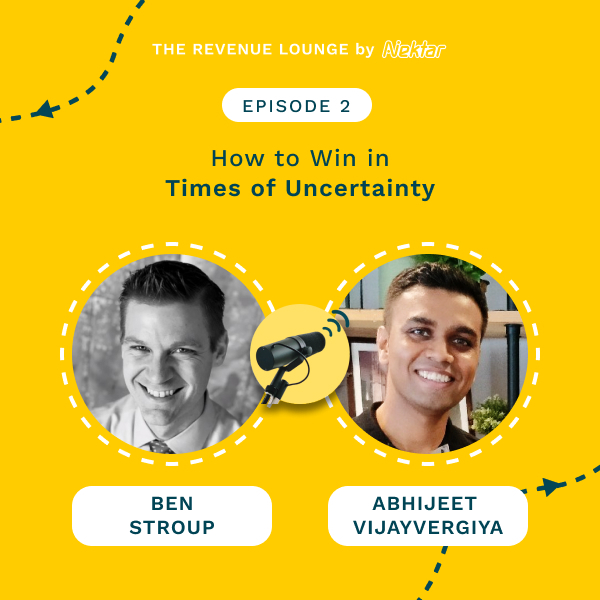
Ep #2: How to Win in Times of Uncertainty
Listen Now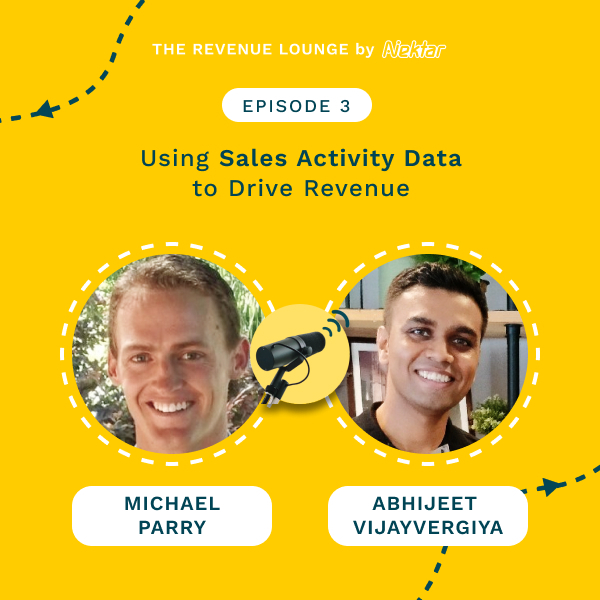
Ep #3: Using Activity Data to Drive Sales Productivity
Listen Now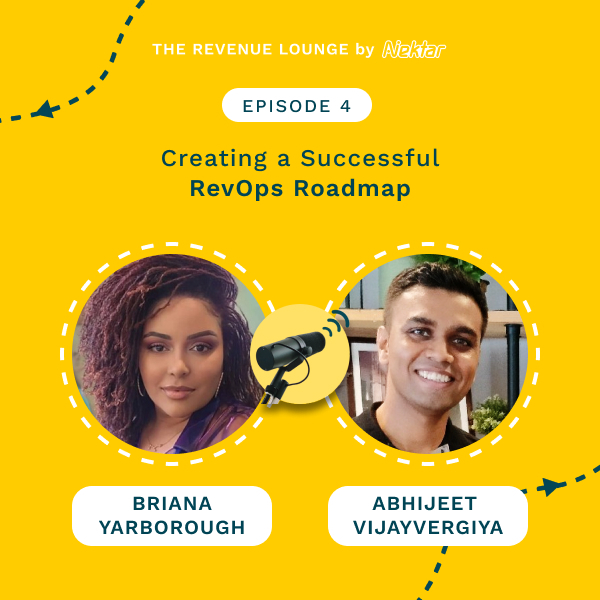
Ep #4: Creating a Successful RevOps Roadmap
Listen Now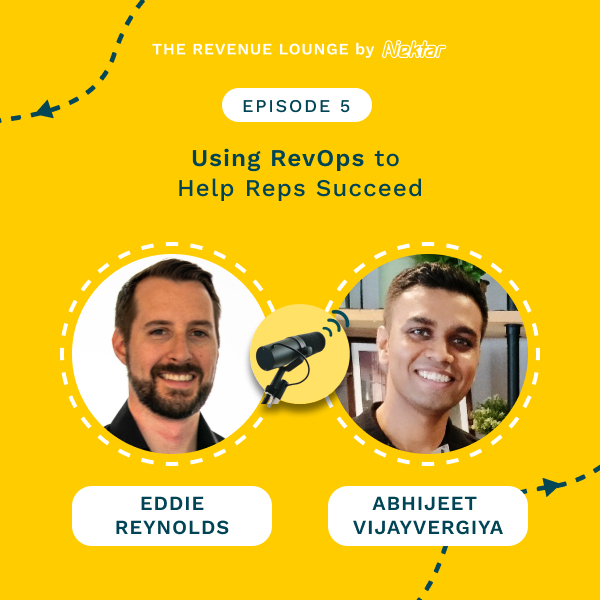
Ep #5: Using RevOps to Help Reps Succeed
Listen Now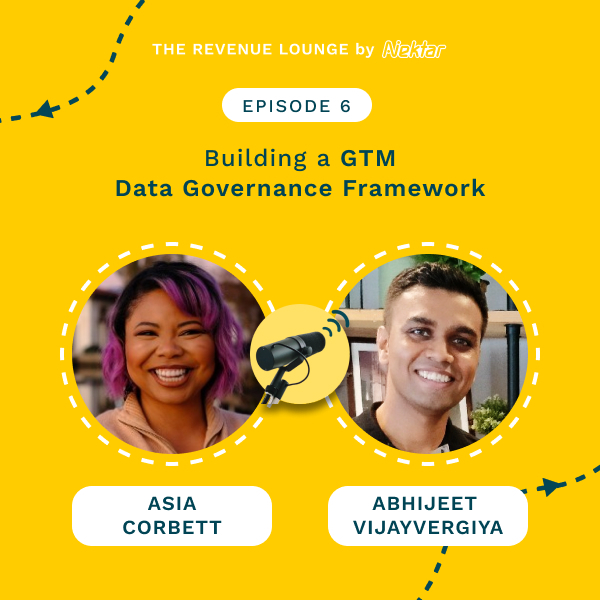
Ep #6: Building a GTM Data Governance Framework
Listen Now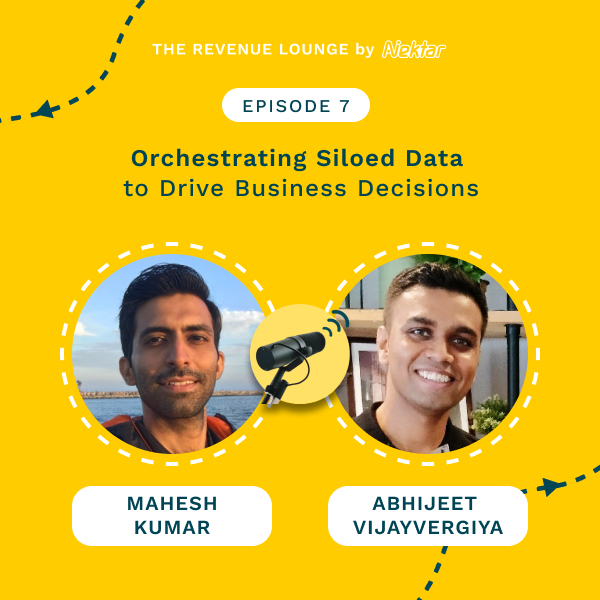
Ep #7: Orchestrating Siloed Data to Drive Business Decisions
Listen Now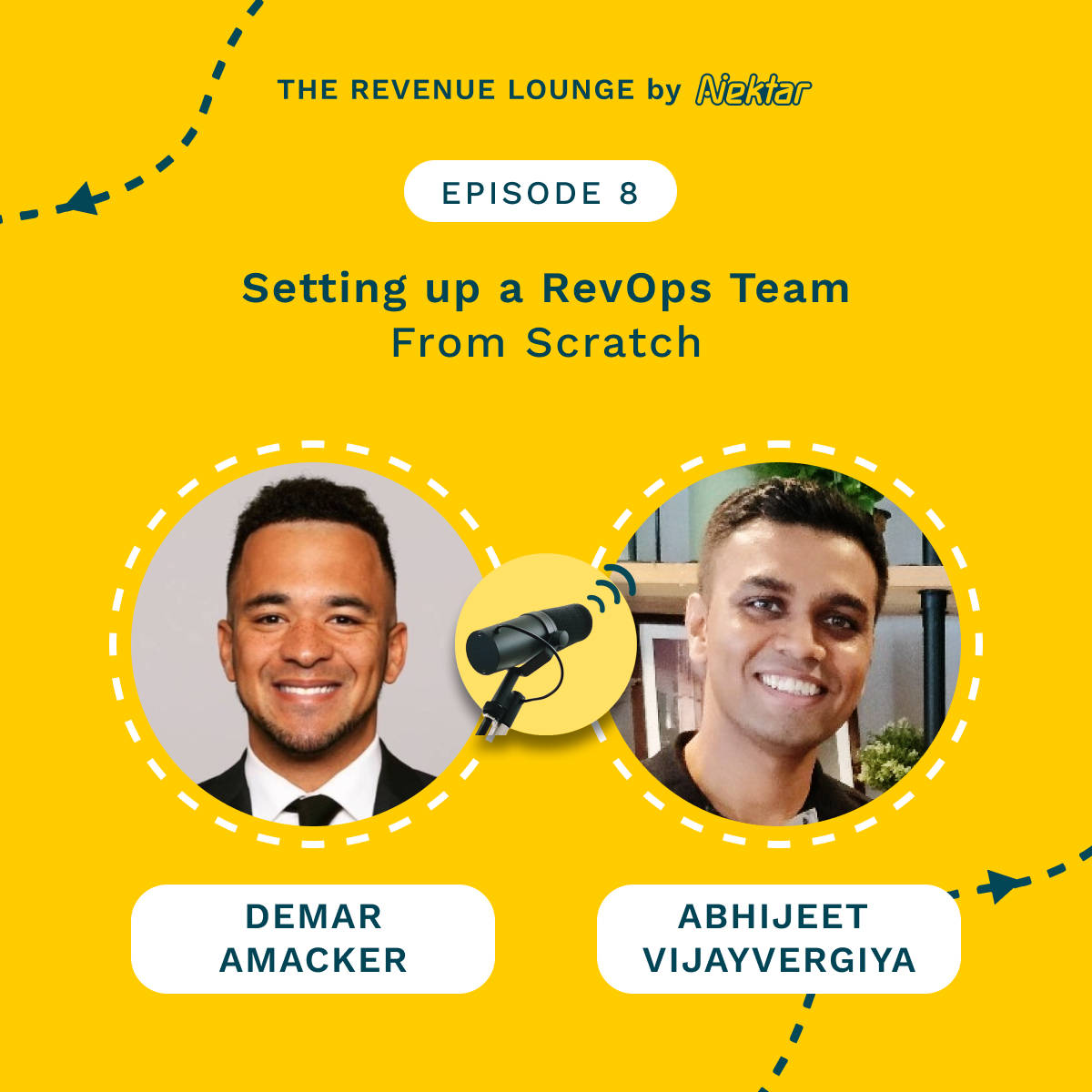
Ep #8: Setting Up a RevOps Team From Scratch
Listen Now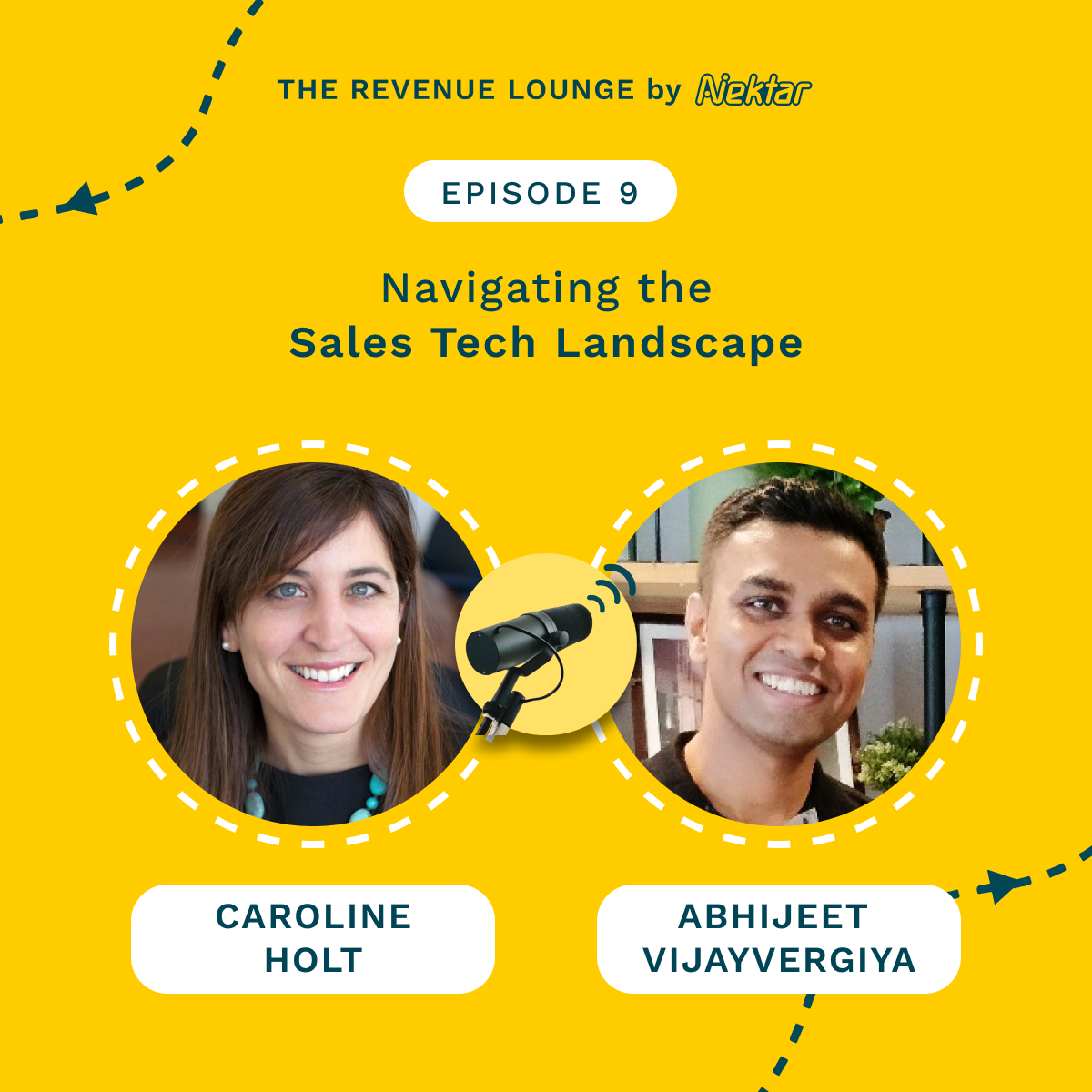
Ep #9: Navigating the Sales Tech Landscape
Listen Now